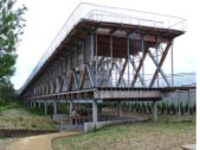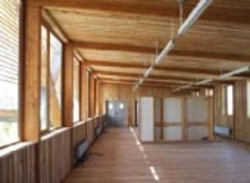Philippe Madec: "Towards another use of the world"
Philippe Madec willingly accepts the role as heir of the "Critical Regionalism" introduced by the famous critic and historian Kenneth Frampton, that had the objective of formulating attentive solutions to climate, ground, crops and other uses without negating progress characterising modernity. Now acting on behalf of a construction project in which sharing and nature are important, the architect was invited to one of the "Carte blanche" meetings organized by CSTB and Archivov and explained that beyond the technical, industrial and political developments of the Modern Movement, "there is room for an architecture that does not totally hide behind popular culture or the learned culture of architects and engineers."
Architecture as sharing
Without giving way to local mimetism or simple regionalism, projects for the commune of Plourin-lès-Morlaix give a perfect illustration of the work done by Philippe Madec. In this small village in North Finistère, a long-term operation started 17 years ago, "cannot be done without the inhabitants, he continues. And the planned buildings, obviously different from buildings that the population is used to seeing, all form a starting point for a sustainable agreement, the challenge not being to know who has authority over the project, but rather what has authority over the project." In other words, the project, the sum of agreements between parties, must be envisaged like sharing. Sharing natural resources, the public space, a local identity and a place at a given time. In Plourin-lès-Morlaix, the best examples are undoubtedly work done on the relation between the sky and the earth, the use of stone extracted from nearby quarries to give work to local industry, or a common reflection within the framework of cooperation actions with the resident population.
Technology, a partial response
For this former teacher at the ENSP (Higher National Landscape School), the architect could be defined as an enterprise that installs life in a material arranged benevolently. "At the same time, the purpose of the High Environmental Quality approach is not to propose a manner of making an architectural project; it is very clearly intended to offer construction procedures." They involve technical devices that can have an impact on the image of a building, and do not suggest genuine aesthetics. As proof, not all designers interested in the environment lose their personal style. Philippe Madec is familiar with natural ventilation systems, rainwater collection systems and solar protection systems, and explains that the exclusively technological environmental solution that is a necessary condition for sustainable development, is not necessarily sufficient.
His architectural and urban approach forms part of a wider environmental framework, "rooted in the earth and its resources", as he likes to put it. In the commune of Pacé near Rennes, the urban development project is not being produced along yet another road in a housing estate landscape, but is nourished from the topography of the site: floodable valley bottoms that are also ecological corridors, will become genuine regional federating instruments.
In Anglet, in the heart of the Basque country, the visitor’s centre at the Izadia Ecological Park has been designed on piles to limit its impact on the ecosystem related to two brine ponds. The building has no elevator, and its length is determined by the length necessary for installation of the access ramp. It is composed almost entirely of Douglas pine wood and larch wood that are renewable materials with very low grey energy.
In Dinan, within the framework of retrofitting of barracks in which 60% of the buildings were preserved, the option of keeping spaces with no immediately defined function creates conditions for genuine future mixity and adaptability of the project in the longer term when needs or requirements have changed.
"At the moment, cars consume less and pollute less, but greenhouse effect gases are still increasing, says Philippe Madec. This means that technology alone cannot provide a solution by which we can envisage a sustainable environment." He invites us to look “towards another way of using the world” in Dinan, Anglet, Pacé or elsewhere, as for automobiles.



